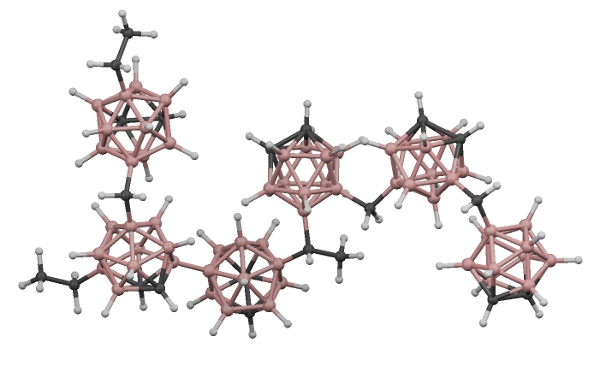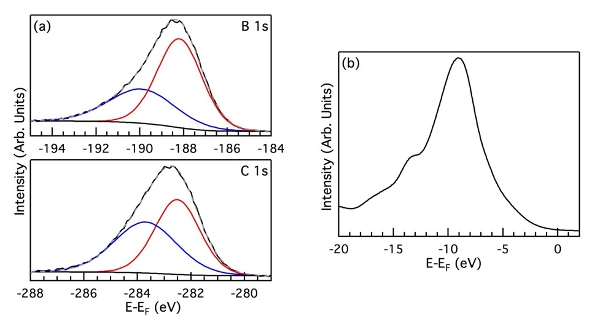www.acsprf.org
Reports: DNI1050444-DNI10: Investigating Electron-Hole Pair Creation and Lifetimes in Amorphous Hydrogenated Boron Carbide
Anthony N. Caruso, PhD , University of Missouri (Kansas City)
Amorphous hydrogenated boron carbide (a-BxC:Hy) is of interest for single-junction wideband photovoltaic energy conversion; it has been shown to produce electronhole pairs (ehp's) over a large energy range (1.2 to 3.5 eV, or 1000 to 300 nm) with high (>50%) quantum efficiency. We have undertaken an effort to study the mechanisms responsible for and lifetimes of ehp generation and recombination in a-BxC:Hy in the context of its electronic and physical/chemical structure. This study will shed light on the viability of a-BxC:Hy or similar boron-rich solids as candidate materials for high-efficiency single-junction photovoltaic cells.
Bulk crystalline boron carbide (BxC) has been heavily studied over the last several decades; it's physical structure—based on an ordered network of twelve-vertex icosahedra and three-atom chains—is fairly well understood, and models for its electronic structure and transport properties exist. This is not true, however, of its amorphous hydrogenated counterpart, whose physical structure is thought to be dominated by a polymeric network of partially hydrogenated, partially cross-linked carborane icosahedra—these differences in physical structure are expected to strongly influence electron and hole transport as well as the positions of the valence and conduction band edges relative to the Fermi level.
This work aims to study the electronic structure of a-BxC:Hy from two angles. First, computationally, the ab initio orthogonalized linear combination of atomic orbitals (OLCAO) method will be applied to calculate the site-resolved partial density of states (DOS) and optical transitions of a-BxC:Hy. Second, experimentally, a resonant time-resolved two-photon photoemission technique will be applied to probe the unoccupied DOS and ehp lifetimes of a-BxC:Hy. In this experiment, a valence electron is initially promoted to an unoccupied band upon photoabsorption in a pump' stage, and then photoexcited past the vacuum level upon absorption of a second photon in a probe' stage, at which point its kinetic energy is analyzed.
In the first phase of this award, we have progressed in several important areas. We have grown a-BxC:Hy films by capacitively coupled plasma-enhanced chemical vapor deposition (PECVD) from a solid-state orthocarborane precursor using a range of process parameters and post-growth thermal treatment conditions. These films were characterized with respect to elemental composition and chemical/physical structure by core-level X-ray photoemission spectroscopy (XPS), Rutherford backscattering spectroscopy (RBS), nuclear reaction analysis (NRA), infrared (IR) spectroscopy, and magic angle spinning (MAS) solid-state nuclear magnetic resonance (SSNMR) spectroscopy.
A major obstacle to the theoretical study of amorphous hydrogenated boron carbide has been the lack of a physical structure model on which to base calculations. The MAS-SSNMR studies formed the backbone of an ambitious local physical structure characterization effort, aimed at producing a structural model from which to develop an understanding of the origin of the electronic, optical, and charge transport properties in this unique material. Our initial work applied a variety of SSNMR techniques to the study of an intermediate PECVD a-BxC:Hy product. Through a determination of 11B, 13C, and 1H chemical shifts obtained via direct-excitation, cross-polarization, and 2D experiments, and their comparison with theoretical shifts of model compounds calculated using density functional theory, we were able to distinguish the number and types of atomic chemical environments in the material. Further, LeeGoldburg cross-polarization and other heteronuclear recoupling MAS-SSNMR experiments provided us with insight into the nature of the BH, CH, and BC connectivities. Taking these results together, we proposed a model for the local physical structure of the intermediate product, which is illustrated and described in Figure 1. MAS-SSNMR experiments on the thin-film product as a function of growth conditions are currently underway. Initial results from the MAS-SSNMR work have been published in the Journal of Physics: Condensed Matter, and the most recent results will be presented at American Chemical Society and American Vacuum Society meetings in October 2011.
Figure 1. Proposed model for the local physical structure of PECVD-grown amorphous hydrogenated boron carbide in line with the following criteria: a B:C ratio of ~3:1, an intra- to extraicosahedral C ratio of ~3:2, a protonated-to-nonprotonated B ratio of ≤3:1 (indicating at least some degree of cross-linking via intraicosahedral B), no strong evidence for extraicosahedral or open-cage borane species, no evidence for a significant amount of deprotonated intraicosahedral C (and therefore no evidence for cross-linking via intraicosahedral C) nor for segregated amorphous C, good evidence for extraicosahedral hydrocarbon species, in particular bridging BCH2B and BC(CH3)B groups or terminal BCH3 and BCH2CH3 groups.
The model represented in Figure 1 is being applied as a starting point in producing a supercell input for OLCAO calculations, which are currently underway. A series of variants on the structure (e.g., type, location, and amount of crosslinking units) will be applied to ascertain the effect of these structural modifications on the electronic and optical properties. The structural model will also be refined based on our most recent MAS-SSNMR results as well as experimental results from two-photon photoemission spectroscopy and other probes of electronic structure.
Prior to conducting the two-photon photoemission experiments at the National Synchrotron Light Source, we have completed X-Ray and UV photoemission spectroscopy experiments on the a-BxC:Hy films (Figure 2). In addition, deep-level transient spectroscopy (DLTS) and positron annihilation lifetime spectroscopy (PALS) measurements are underway to gain further insight into defects contributing to the electrical and optical properties.
Figure 2. Representative core level (a) and valence band (b) photoemission spectra of a-BxC:Hy films.
Funds from this doctoral new investigator grant have proven invaluable to advancing the PI's research program, a few years into his independent career. During the period of the award, Prof. Caruso was promoted with tenure from Assistant to Associate Professor. ACS-PRF funds have supported both an undergraduate and a graduate student, who have received significant experience and training in experimental condensed matter physics. This project has so far generated one publication and several conference presentations, with several publications expected upon completion of the proposed work. Award funds have additionally facilitated minor upgrades to our custom-built PECVD chamber, a backbone to the group's research program, bringing it closer to our targeted state-of-the-art system.


